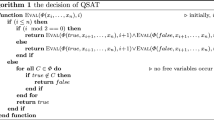Abstract
It is known that dissolution rules are necessary in polarizationless P systems with active membranes to solve problems beyond \(\mathbf {AC^0}\) using reasonable tight uniformity conditions (Murphy and Woods, Fundam Inf Series 134:129–152, 2014). On the other hand, no solutions of such problems exist using only dissolution rules. In this paper, we show that the \(\mathbf {NL}\)-complete reachability problem can be solved in polynomial time by polarizationless P systems with active membranes using only dissolution rules under a suitable uniformity condition.



Similar content being viewed by others
Explore related subjects
Discover the latest articles, news and stories from top researchers in related subjects.References
Alhazov A, Martín-Vide C, Pan L (2003) Solving a \(\rm PSPACE\)-complete problem by P systems with restricted active membranes. Fundam Inf Series 58:67–77
Alhazov A, Pérez-Jiménez MJ (2007) Uniform solution of QSAT using polarizationless active membranes. In: International conference on machines, computations and universality, pp 122-133
Gazdag Z, Hajagos K, Iván Sz (2021) On the power of P systems with active membranes using weak non-elementary membrane division. J Membr Comput 3:258–269
Gazdag Z, Gutiérrez-Naranjo MA (2014) Solving the ST-connectivity problem with pure membrane computing techniques. In: Gheorghe, M., Rozenberg, G., Salomaa, A., Sosík, P., Zandron, C. (Eds.) Membrane Computing: 15th International Conference, LNCS vol. 8961, pp 215–228
Gazdag Z, Kolonits G (2019) A new method to simulate restricted variants of polarizationless P systems with active membranes. J Membr Comput 1(4):251–261
Gensler HJ (2002) Introduction to Logic. Routledge, London
Gutierrez-Naranjo MA, Perez-Jimenez MJ, Riscos-Núñez A, Romero-Campero FJ (2006) On the power of dissolution in P systems with active membranes. In: Freund, R., Păun, Gh., Rozenberg, G., Salomaa, A. (Eds.) Membrane computing: 6th international workshop, LNCS vol. 3850, pp 224–240
Jones ND (1975) Space-bounded reducibility among combinatorial problems. J Comput Syst Sci 11(1):68–85
Krishna SN, Rama R (1999) A variant of P systems with active membranes: solving NP-complete problems. Roman J Inf Sci Technol 2(4):357–367
Leporati A, Manzoni L, Mauri G, Porreca AE, Zandron C (2014) Simulating elementary active membranes, with an application to the P conjecture. In: M. Gheorghe, G. Rozenberg, A. Salomaa, P. Sosík, C. Zandron (Eds.) Membrane Computing – 15th international conference, CMC15, LNCS vol. 8961, pp 284–299
Leporati A, Manzoni L, Mauri G, Porreca AE, Zandron C (2017) Solving a special case of the P conjecture using dependency graphs with dissolution. In: Gheorghe, M., Rozenberg, G., Salomaa, A., Zandron, C. (Eds.) Membrane Computing: 18th international conference, LNCS vol. 10725, pp 196-213
Murphy N, Woods D (2007) Active membrane systems without charges and using only symmetric elementary division characterise P. In: Eleftherakis, G., Kefalas, P., Păun, Gh., Rozenberg, G., Salomaa, A. (Eds.) Membrane Computing: 8th international workshop, LNCS vol. 4860, pp 367–384
Murphy N, Woods D (2008) A characterisation of NL using membrane systems without charges and dissolution. In: Calude, C.S., da Costa, J.F.G., Freund, R., Oswald, M., Rozenberg, G. (Eds.) Unconventional Computing: 7th International Conference, LNCS vol. 5204, pp 164–176
Murphy N, Woods D (2009) On acceptance conditions for membrane systems: characterisations of \(\mathbf{L}\) and \(\mathbf{NL}\). In Neary, T., Woods, D., Seda, T., Murphy, N., (Eds)., Proceedings of the international workshop on the complexity of simple programs, Cork, Ireland, Vol. 1 of Electronic proceedings in theoretical computer science., Open Publishing Association, pp 172–184
Murphy N, Woods D (2014) Uniformity is weaker than semi-uniformity for some membrane systems. Fundam Inf Series 134(1–2):129–152
Orellana-Martín D, Riscos-Núnez A (2020) Seeking computational efficiency boundaries: the Păun’s conjecture. J Membr Comput 2:323–331
Păun Gh (2001) P systems with active membranes: attacking NP-complete problems. J Automata, Lang Comb Series 6(1):75–90
Păun Gh (2005) Further twenty six open problems in membrane computing. In: Third brainstorming week on membrane computing, pp. 249–262. Fénix Editora, Sevilla
Păun Gh, Rozenberg G, Salomaa A (eds) (2010) The Oxford Handbook of Membrane Computing. Oxford University Press, Oxford, England
Pérez-Jiménez MJ, Romero-Jiménez Á, Sancho-Caparrini F (2006) A polynomial complexity class in P systems using membrane division. J Autom Lang Comb 11(4):423–434
Salomaa A (1973) Formal Languages. Academic Press, New York, London
Sosík P (2003) The computational power of cell division in P systems. Natural Computing series 2(3):287–298
Sosík P (2019) P systems attacking hard problems beyond NP: a survey. J Membr Comput 1:198–208
Sosík P, Rodríguez-Patón A (2007) Membrane computing and complexity theory: a characterization of PSPACE. J Comput Syst Sci Series 73(1):137–152
Woods D, Murphy N, Pérez-Jiménez MJ, Riscos-Núnez A (2009) Membrane dissolution and division in P. In: Calude, C.S., da Costa, J.F.G., Dershowitz, N., Freire, E., Rozenberg, G. (Eds.) Unconventional Computation: 8th international conference, LNCS vol. 5715, pp 262–276
Zandron C, Ferretti C, Mauri G (2001) Solving NP-complete problems using P systems with active membranes. In: Unconventional models of computation, UMC’2K: Proceedings of the Second international conference on unconventional models of computation. Springer London, London, pp 289–301
Acknowledgements
We thank the anonymous reviewers for their constructive comments, which helped us to improve the manuscript. This research was supported by project TKP2021-NVA-09, implemented with the support provided by the Ministry of Innovation and Technology of Hungary from the National Research, Development and Innovation Fund, financed under the TKP2021-NVA funding scheme.
Author information
Authors and Affiliations
Corresponding author
Additional information
Publisher's Note
Springer Nature remains neutral with regard to jurisdictional claims in published maps and institutional affiliations.
Rights and permissions
Springer Nature or its licensor (e.g. a society or other partner) holds exclusive rights to this article under a publishing agreement with the author(s) or other rightsholder(s); author self-archiving of the accepted manuscript version of this article is solely governed by the terms of such publishing agreement and applicable law.
About this article
Cite this article
Gazdag, Z., Hajagos, K. On the power of membrane dissolution in polarizationless P systems with active membranes. Nat Comput 22, 95–104 (2023). https://doi.org/10.1007/s11047-022-09926-x
Accepted:
Published:
Issue Date:
DOI: https://doi.org/10.1007/s11047-022-09926-x




